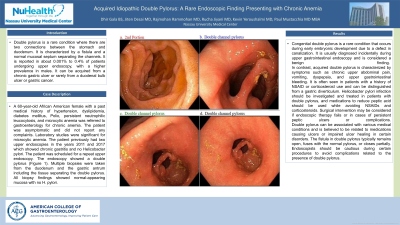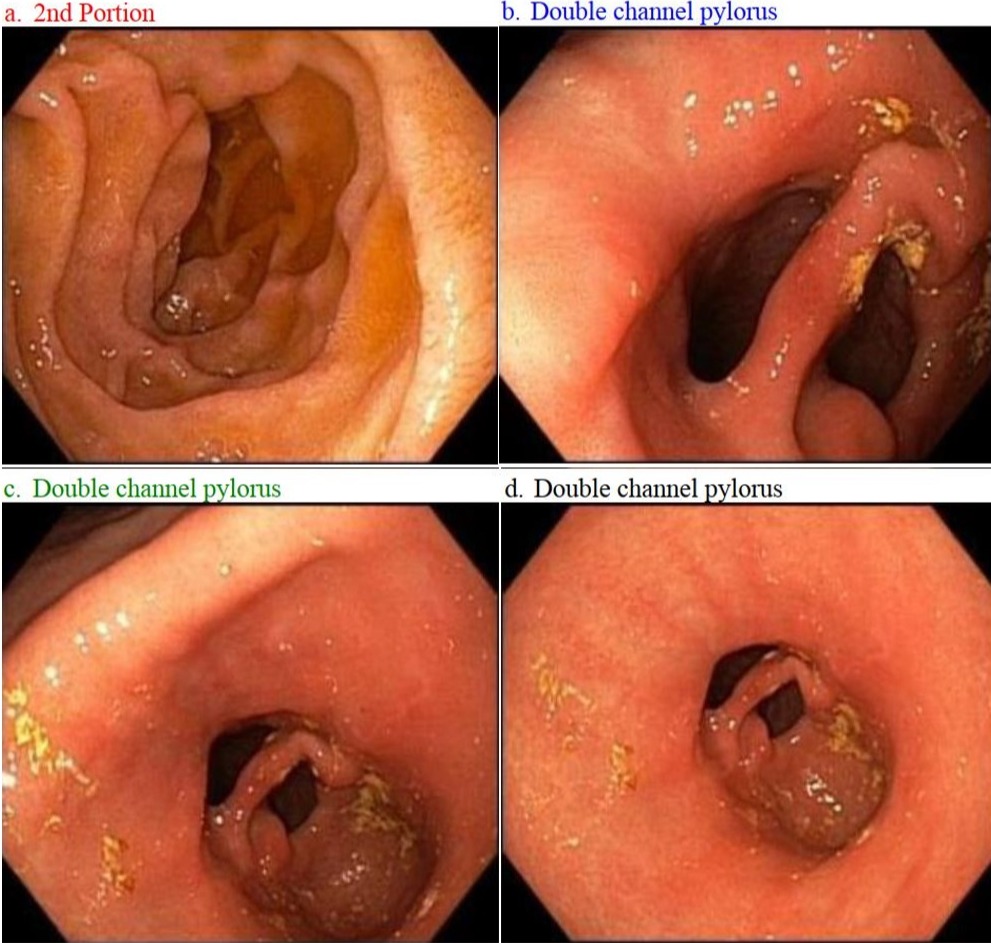Monday Poster Session
Category: Stomach
P2788 - Acquired Idiopathic Double Pylorus: A Rare Endoscopic Finding Presenting With Chronic Anemia
Monday, October 23, 2023
10:30 AM - 4:15 PM PT
Location: Exhibit Hall

- JD
Jiten Desai, MD
Nassau University Medical Center
East Meadow, NY
Presenting Author(s)
Dhir Gala, BS1, Jiten Desai, MD2, Rajmohan Rammohan, MD2, Rucha Jiyani, MD2, Kevin Yeroushalmi, MD2, Paul Mustacchia, MD, MBA2
1American University of the Caribbean School of Medicine, Plainview, NY; 2Nassau University Medical Center, East Meadow, NY
Introduction: Double pylorus is a rare condition where there are two connections between the stomach and duodenum. It is characterized by a fistula and a normal mucosal septum separating the channels. It is reported in about 0.001% to 0.4% of patients undergoing upper endoscopy, with a higher prevalence in males. It can be acquired from a chronic gastric ulcer or rarely from a duodenal bulb ulcer or gastric cancer.
Case Description/Methods: A 60-year-old African American female with a past medical history of hypertension, dyslipidemia, diabetes mellitus, Polio, persistent neutrophilic leucocytosis, and microcytic anemia was referred to gastroenterology for chronic anemia. The patient was asymptomatic and did not report any complaints. Laboratory studies were significant for microcytic anemia. The patient previously had two upper endoscopies in the years 2011 and 2017 which showed chronic gastritis and no Helicobacter pylori. The patient was scheduled for a repeat upper endoscopy. The endoscopy showed a double pylorus (Figure 1). Multiple biopsies were taken from the duodenum and the gastric antrum including the tissue separating the double pylorus. All biopsy findings showed normal-appearing mucosa with no H. pylori.
Discussion: Congenital double pylorus is a rare condition that occurs during early embryonic development due to a defect in canalization. It is usually diagnosed incidentally during upper gastrointestinal endoscopy and is considered a benign finding.
In contrast, acquired double pylorus is characterized by symptoms such as chronic upper abdominal pain, vomiting, dyspepsia, and upper gastrointestinal bleeding. It is often seen in patients with a history of NSAID or corticosteroid use and can be distinguished from a gastric diverticulum. Helicobacter pylori infection should be investigated and treated in patients with double pylorus, and medications to reduce peptic acid should be used while avoiding NSAIDs and corticosteroids. Surgical intervention may be considered if endoscopic therapy fails or in cases of persistent peptic ulcers or complications.
Double pylorus can be associated with various medical conditions and is believed to be related to medications causing ulcers or impaired ulcer healing in certain disorders. The fistula in double pylorus typically remains open, fuses with the normal pylorus, or closes partially. Endoscopists should be cautious during certain procedures to avoid complications related to the presence of double pylorus.

Disclosures:
Dhir Gala, BS1, Jiten Desai, MD2, Rajmohan Rammohan, MD2, Rucha Jiyani, MD2, Kevin Yeroushalmi, MD2, Paul Mustacchia, MD, MBA2. P2788 - Acquired Idiopathic Double Pylorus: A Rare Endoscopic Finding Presenting With Chronic Anemia, ACG 2023 Annual Scientific Meeting Abstracts. Vancouver, BC, Canada: American College of Gastroenterology.
1American University of the Caribbean School of Medicine, Plainview, NY; 2Nassau University Medical Center, East Meadow, NY
Introduction: Double pylorus is a rare condition where there are two connections between the stomach and duodenum. It is characterized by a fistula and a normal mucosal septum separating the channels. It is reported in about 0.001% to 0.4% of patients undergoing upper endoscopy, with a higher prevalence in males. It can be acquired from a chronic gastric ulcer or rarely from a duodenal bulb ulcer or gastric cancer.
Case Description/Methods: A 60-year-old African American female with a past medical history of hypertension, dyslipidemia, diabetes mellitus, Polio, persistent neutrophilic leucocytosis, and microcytic anemia was referred to gastroenterology for chronic anemia. The patient was asymptomatic and did not report any complaints. Laboratory studies were significant for microcytic anemia. The patient previously had two upper endoscopies in the years 2011 and 2017 which showed chronic gastritis and no Helicobacter pylori. The patient was scheduled for a repeat upper endoscopy. The endoscopy showed a double pylorus (Figure 1). Multiple biopsies were taken from the duodenum and the gastric antrum including the tissue separating the double pylorus. All biopsy findings showed normal-appearing mucosa with no H. pylori.
Discussion: Congenital double pylorus is a rare condition that occurs during early embryonic development due to a defect in canalization. It is usually diagnosed incidentally during upper gastrointestinal endoscopy and is considered a benign finding.
In contrast, acquired double pylorus is characterized by symptoms such as chronic upper abdominal pain, vomiting, dyspepsia, and upper gastrointestinal bleeding. It is often seen in patients with a history of NSAID or corticosteroid use and can be distinguished from a gastric diverticulum. Helicobacter pylori infection should be investigated and treated in patients with double pylorus, and medications to reduce peptic acid should be used while avoiding NSAIDs and corticosteroids. Surgical intervention may be considered if endoscopic therapy fails or in cases of persistent peptic ulcers or complications.
Double pylorus can be associated with various medical conditions and is believed to be related to medications causing ulcers or impaired ulcer healing in certain disorders. The fistula in double pylorus typically remains open, fuses with the normal pylorus, or closes partially. Endoscopists should be cautious during certain procedures to avoid complications related to the presence of double pylorus.

Figure: Figure 1. Endoscopic view demonstrating double pylorus.
Disclosures:
Dhir Gala indicated no relevant financial relationships.
Jiten Desai indicated no relevant financial relationships.
Rajmohan Rammohan indicated no relevant financial relationships.
Rucha Jiyani indicated no relevant financial relationships.
Kevin Yeroushalmi indicated no relevant financial relationships.
Paul Mustacchia indicated no relevant financial relationships.
Dhir Gala, BS1, Jiten Desai, MD2, Rajmohan Rammohan, MD2, Rucha Jiyani, MD2, Kevin Yeroushalmi, MD2, Paul Mustacchia, MD, MBA2. P2788 - Acquired Idiopathic Double Pylorus: A Rare Endoscopic Finding Presenting With Chronic Anemia, ACG 2023 Annual Scientific Meeting Abstracts. Vancouver, BC, Canada: American College of Gastroenterology.
